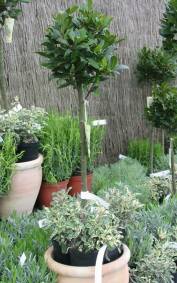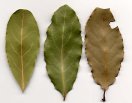Categories
Calendars
Guides
Reviews
Archive
Gallery
Articles
Ask Our Gardening Expert
Bay Laurel in Containers and Standard Bay Trees
Container
Growing Bay Trees Bay trees are very suited to being indoor
plants in the winter. Keep them in a cool position that is open to
indirect sunlight. Bay laurel likes to be pot bound and can stay in its
final 30cm (12 in) container for six years or more. After this, repot
into a container which is about 5cm (2 in) wider. Ensure that the base
of the pot has good drainage (use broken clay pot on the base of the
pot) and fill in with a loam based potting compost such as John Innes. This will
provide a neutral soil (i.e. not ericaceous) which has more body to it than a peat based
potting compost. Feed container grown bay in mid-spring and then more
regularly (every fortnight) during the summer growing period. In early
spring, remove the top 2.5cm (1 in) of compost and replace it with new
compost.
Create a Bay Standard When the bay laurel tree is about 20cm (8in) higher than the final
height, cut out the topmost growing tip. Clip back the remaining side
shoots to about 3 leaves. This will encourage the head of the bay laurel plant to
grow and it will soon begin to form the traditional 'ball' shape. As more side shoots appear, trim them back to about 3 leaves. When
the bay is fully-shaped, prune in late spring and late summer to
maintain its shape. Using Bay Laurel as a Herb
Bay trees thrive in containers, making them ideal for the patio. They will require
an annual trim in the autumn to shape them and a liquid feed throughout the summer.
The size of the pot will control the size of the Bay tree - a 30cm (12in) diameter
pot will produce a reasonable size tree of about 1.5m (5ft). If a hard frost
threatens, move the tree inside to a cool room.
 Standard bays look very attractive in containers especially
half-barrels. To form a bay standard, buy a young plant with as straight
a stem as possible. As the plant grows, remove all lower side shoots,
but keep the top side-shoots.
Standard bays look very attractive in containers especially
half-barrels. To form a bay standard, buy a young plant with as straight
a stem as possible. As the plant grows, remove all lower side shoots,
but keep the top side-shoots.
 Bay leaves are used extensively in French, Italian, Spanish and Creole
cooking. They are used to flavour soups, stews, shellfish, pickling
brines, sauces, marinades, poultry and fish dishes. Always remove the
bay leaves from the food before serving, because they are sharp and can
cut the mouth and throat. French chefs place bay leaves, parsley and
thyme in a little bundle called a bouquet garni that is removed
after cooking. Pick bay leaves early in the day and dry quickly, out of
sunlight, under weight so they won't curl. Store in an air-tight jar and
they will keep their flavour for up to a year.
Bay leaves are used extensively in French, Italian, Spanish and Creole
cooking. They are used to flavour soups, stews, shellfish, pickling
brines, sauces, marinades, poultry and fish dishes. Always remove the
bay leaves from the food before serving, because they are sharp and can
cut the mouth and throat. French chefs place bay leaves, parsley and
thyme in a little bundle called a bouquet garni that is removed
after cooking. Pick bay leaves early in the day and dry quickly, out of
sunlight, under weight so they won't curl. Store in an air-tight jar and
they will keep their flavour for up to a year.
Name: jim@GardenAction
E-mail: webmaster@gardenaction.co.uk
Date posted: December 05, 2011 - 09:18 pm
Message: There should be plenty of dormant buds in the stem. Prune off above them at the height you want.
Name: gerard
E-mail: fortry2008@hotmail.com
Date posted: December 05, 2011 - 02:48 am
Message: hi
i have a bayleaf tree in a big pot that is becoming too big,how to cut it down to size without killing it ?
Thank you
Name: Tailynn
E-mail: slinkp@angelfire.com
Date posted: August 08, 2011 - 06:28 am
Message: Ho ho, who woldua thunk it, right?
Name: Mr C Jacob
E-mail: Private
Date posted: May 03, 2011 - 08:39 am
Message: Step dauters bay trees, the bark is starting to split and flake is this normal.
Thank you.
Name: T Tappenden
E-mail: Private
Date posted: January 23, 2011 - 06:22 am
Message: I have three bay trees in pots. 2 look healthy but the 3rd is suffering with a leaf problem. The leaf area between the veins appears to be dying and the entire leaf appears copper coloured. I can see no obvious pests and the tree was fed in the summer with slow release fertilizer. All the leaves appear equally affected. Is this cold damage, or water logging? What can I do to rescue my poor tree. Any advice welcome
Name: Wendy HART
E-mail: Private
Date posted: October 14, 2010 - 03:23 pm
Message: I have a bay leaf plant it growing like a V and is thick at the bottom with leafs. can I devid or split the plant